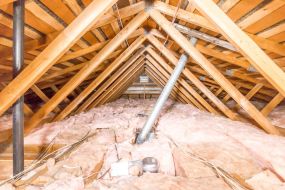Attic Insulation Removal – What They Don’t Tell You

Attic insulation is one of the most precarious things to deal with in a home. Contractors are happy to take your money for an attic insulation job, flood your attic with fiberglass or cellulose insulation, put up some loose plywood barriers to prevent it from migrating toward the attic door and then walk away. Afterwards, you are upset because your house is still cold and drafty, even after new insulation was just put in. Maybe after ten months of putting up with the cold, you go up to the attic one day and notice that the entire area is laden with mold spores. Now, to get rid of the mold, you must make a plan for attic insulation removal.
Case Study
The instinct to blame the attic contractor is the correct one. The homeowner bought this single detached house five years ago. It was built during a major boom in the 1970s and needed a few upgrades. One of the first was to swap out the old lighting fixtures in the ceiling with new ones that were more compatible with the modern LED bulbs. This upgrade disrupted the ceiling drywall a little bit. It created a small circular ring around every ceiling light that got replaced, where warm, humid air from inside could escape upward into the unsealed, poorly constructed attic. The homeowner, upon noticing the sudden cold, reached out to a contractor who explained that these older houses have attics that are not very well insulated. The solution was, instead of doing an expensive attic insulation removal job, would be to simply pile modern high efficiency cellulose insulation atop the existing stuff.
What don’t you know?
What the contractor neglected to tell our homeowner is that the real reason why the cold started when it did is because the builder did a poor job sealing the attic. In their haste to build quickly and cheaply, the builder left tiny, unsealed hairline cracks between the plywood laid above the ceiling. For all those years the ceiling drywall provided an airtight seal that covered this flaw, but once those light fixtures got replaced and the ceiling drywall was cut into, that changed. The house got colder because warm humid air from inside was escaping through the ceiling and into the attic, where it began to condense on the wooden beams. When the homeowner complained about the cold to the attic contractor, the proper thing would have been to do attic insulation removal to get at the cracks in the wood beneath and repair them.
Why wasn’t it done right?
Because most houses built before 1990 contain vermiculite attic insulation, which is asbestos based, the contractor would have had to use sophisticated safety equipment and machinery to abate the asbestos. Instead of doing the ethical thing and referring the homeowner to someone who could do it right, the contractor decided to flood the attic with cellulose and walk away. Cellulose is a plant-based compound, which means it is an ample food source for mold spores. When the warm, humid air from inside the house started entering the cold attic, the resulting condensation enabled the first mold spores to appear on the wooden planks. The cellulose insulation on the spores acted as gasoline, igniting the mold bomb.
Why you must call the professionals
Now our homeowner is about to walk into a death trap. The attic is laden with mold and asbestos. Wearing a fine particulate mask and goggles is nowhere near enough protection from the respiratory dangers that await. The attic insulation removal must be done by a crew that uses hazmat suits with respiration devices, where the air quality is monitored while the work proceeds. Once the asbestos and cellulose has been abated, they must replace any planks that have rotted, and seal all of the fine cracks with foam guns. Any insulation that is put in the attic afterwards is there merely to preserve the attic as a storage space.
If you are concerned about any potential ceiling heat loss, you should choose a contractor that is committed to investigating attic sealing issues. Also, pick one that can safely abate anything harmful that might be up there, instead of offering a band-aid solution.







